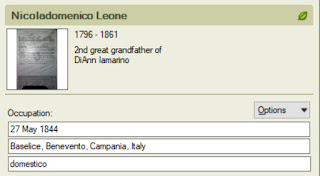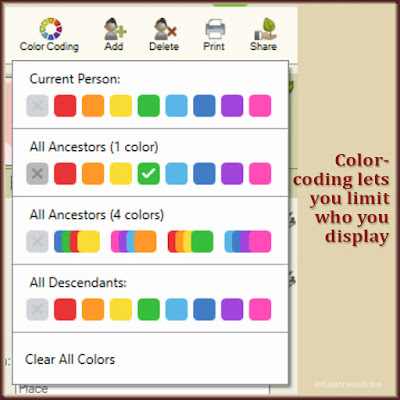 |
| I record occupations in my ancestor's language. |
Years ago I dove headfirst into transcribing Italian vital records for my family tree. I visited a Family History Center, viewed the microfilm, and typed into my laptop. I memorized the Italian words for numbers, months and family members.
When a document included a person's occupation, I typed the Italian word and kept going. I didn't translate the words on the spot, but later I created a file of Italian occupations and their English definitions.
 |
| My Italian occupations cheat-sheet. |
The translation file helped me memorize many words, but I entered only the Italian occupation in my family tree. I felt it made sense for my ancestors who never left Italy.
But now I'm thinking more about my family tree as a legacy. If someone else continues my work, these Italian words may not be understood.
Wouldn't it be better to include the Italian word and its English translation? Uh oh. How can I make this sweeping change to my tree of more than 19,000 people?
 |
| Hiding in plain sight. |
I decided to try the Find and Replace feature in Family Tree Maker. It's in the Edit menu.
You can use find and replace to makes lots of improvements and corrections. But be careful. Think hard about unintended changes that might happen. For example, if you wanted to replace "Smith" because you found out your ancestors were actually named Smythe, what would happen to your cousin who was born in Smithtown, Long Island?
I did a test changing "calzolaio" to "calzolaio (shoemaker)". I checked the boxes to find whole words only and look only in facts and notes. Then I clicked Replace All.
It was a success.
 |
| Click once, fix 180 entries. Not bad! |
Now I can work through the most common Italian occupations in my family tree. Then I'll look at some other facts I wish I'd recorded differently. For example, long ago I recorded every immigration fact the same way, beginning with the words, "Arrived aboard the..." followed by the ship name. Later I changed where I put the ship name. Maybe I can use find and replace to bring more uniformity to my facts.
 |
| It's more useful with the English translation. |
The lion's share of the people in my family tree were born and died in Italy. I believe in preserving some of their facts in Italian. Aside from occupations, I record the Italian names of the churches where they married. Chiesa di San Leonardo Abate and Chiesa di San Giorgio Martire.
Think about two things:
- Which original-language facts do you want to preserve?
- How can you prevent that foreign-language information from losing its meaning?
Does your family tree software have a find and replace feature?




